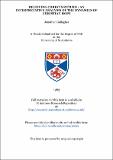Files in this item
Believing Christ's return : an interpretative analysis of the dynamics of Christian hope
Item metadata
| dc.contributor.advisor | Hall, G. B. | |
| dc.contributor.author | Gallagher, Jonathan | |
| dc.coverage.spatial | 518 p. | en_US |
| dc.date.accessioned | 2018-05-28T08:58:13Z | |
| dc.date.available | 2018-05-28T08:58:13Z | |
| dc.date.issued | 1983-07 | |
| dc.identifier.uri | https://hdl.handle.net/10023/13555 | |
| dc.description.abstract | This study investigates the dynamic of hope, specifically the Christian hope as it is expressed in the expectation of Christ's return. This belief has a number of implications, and affects the believer's attitude to God, man and the world, the relationship to past, present and future events, and the understanding of meaning and purpose in life. The examination of the belief in the parousia is primarily concerned with the question "why?" The question "Why the parousia?" is basic to this thesis, and the various sections reflect the different modes of answer. Section One examines the belief as it is portrayed in the New Testament by a brief review of its role and importance (with several examples), followed by a more interpretative analysis of the concept of the "God who comes," and the implications of the parousia parables. Section Two provides a wide-ranging summary of the different manifestations of the parousia hope in Christian history, along with some comment and analysis of its influences and consequences. Section Three illustrates the implications and effects of a strong parousia belief through an account of the nineteenth century Millerite movement. Section Four, enters into greater detail with an examination of the role that the parousia belief plays within a group that strongly affirms its importance: the Seventh-day Adventist Church. This examination is both on a personal and community level, and provides considerable material for understanding the factors influencing the adoption and consequent effects of this belief. Section Five reviews the interpretation of the parousia belief in modern theology and comments on the relative attitudes and outlooks that result both from an acceptance of the belief and from its denial. This leads on to a discussion of the concept of the "delay," a major influence on the parousia belief in contemporary thought. Section Six provides some synthesis of the various elements of the parousia belief, and also indicates other more abstract implications and components. The parousia belief is seen as a part of an ordered belief structure; then as a major belief in terms of hope, consummation, termination, purpose, vindication and so on. Yet finally it is the temporal aspect so frequently noted in other Sections that is of greatest importance, and the interaction of time and the parousia provides the conclusion -- the concept of a dynamic, time-related belief that activates the present out of the future. | en_US |
| dc.language.iso | en | en_US |
| dc.publisher | University of St Andrews | |
| dc.subject.lcc | BT885.G2 | en |
| dc.subject.lcsh | Second Advent. | en |
| dc.subject.lcsh | Hope--Religious aspects--Christianity. | en |
| dc.title | Believing Christ's return : an interpretative analysis of the dynamics of Christian hope | en_US |
| dc.type | Thesis | en_US |
| dc.type.qualificationlevel | Doctoral | en_US |
| dc.type.qualificationname | PhD Doctor of Philosophy | en_US |
| dc.publisher.institution | The University of St Andrews | en_US |
This item appears in the following Collection(s)
Items in the St Andrews Research Repository are protected by copyright, with all rights reserved, unless otherwise indicated.

